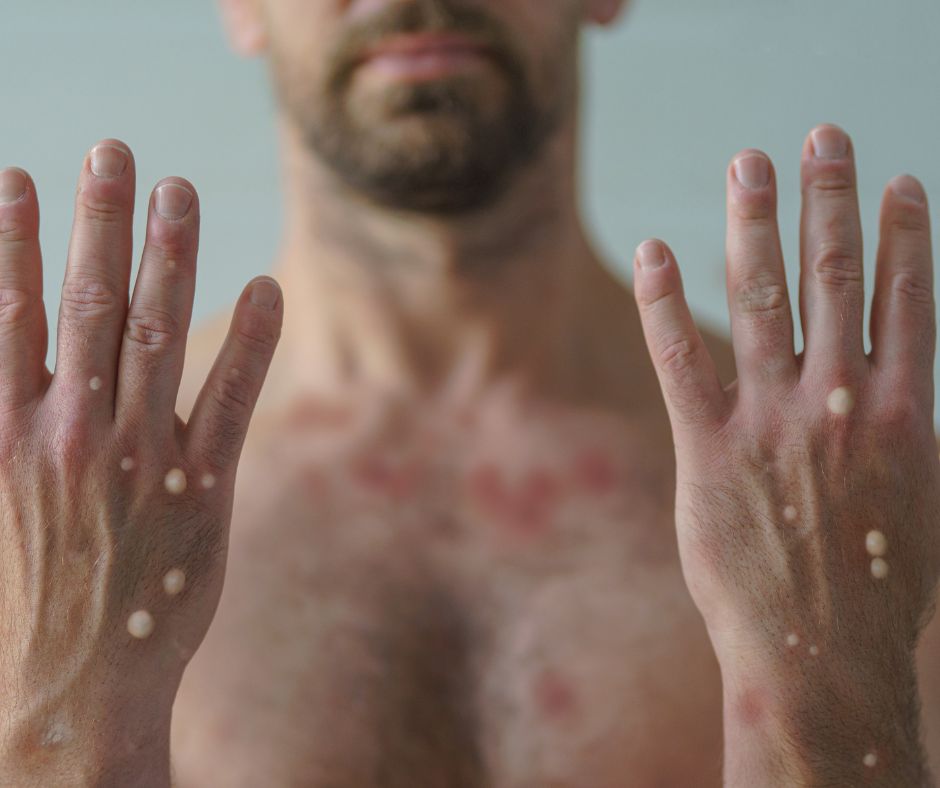Monkeypox has come to the world’s attention in recent months, with increasing numbers being seen globally. The virus has even made its way into Western Australia, with the first case reported in a returned traveller on the 4th August.
In this month’s blog, we take a closer look at monkeypox to find out who’s most at risk and how you can prevent catching the disease.

What is monkeypox?
Monkeypox is not a new virus. It was first discovered in 1958 in colonies of monkeys kept for research in Africa, hence the name ‘monkeypox’.
While it is a viral zoonotic disease, which means it can spread between animals and humans, the virus doesn’t actually come from monkeys. In fact, it is more commonly spread via rodents.
Monkeypox is from the same family of viruses as the variole virus, which causes smallpox.
The first human case of the disease was identified in 1970 and occurs most commonly in the tropical rainforest areas of Central and West Africa. It has previously been found in other countries, mostly in those who have travelled to these regions.
In May of this year, we started to see a global increase in monkeypox infections in countries where the illness is not usually present, including here in Australia. As such, the World Health Organization recently declared the virus a public health emergency of international concern.
Common symptoms
Symptoms usually start within 3 weeks of exposure to the virus and include:
- a distinctive rash, lesions (bumps that turn into pimples, blisters or sores, and may burst to form ulcers or scabs)
- swollen lymph nodes
- fever
- headache
- muscle aches
- joint pain
- back pain
- chills
- exhaustion

The distinctive rash can appear as lesions of various size and number. They look similar to the blisters associated with chickenpox, but are generally larger and can burst to form ulcers or scabs.
The rash, which can be very painful, generally starts on the face and spreads to other parts of the body, including hands, feet, and chest. Some people have also reported the rash appearing in the genital and perianal regions, without spreading to other areas of the body.
While the disease can be serious and cause some people to become very ill, most people slot luar negeri will find their symptoms clear up on their own after 2 to 4 weeks.
If you do develop monkeypox and experience any of the following symptoms, please seek medical help immediately:
- your rash becomes very painful and/or gets infected
- your fever, nausea or vomiting gets worse
- you can’t eat or drink
- you have difficulty breathing or feel dizzy and confused
How do you get monkeypox?
Monkeypox is spread from person to person through:
- close contact with rashes, blisters or sores on the skin
- body fluids, including respiratory droplets from coughing or sneezing
- contaminated objects such as linen and towels.
The virus can also be transmitted in pregnancy, via the placenta to the foetus.
While it is not regarded as a sexually transmitted infection (STI), it can be easily transmitted through sexual activity involving physical contact with the infectious skin rashes, blisters and sores.

It is recommended that people who have recovered from the virus continue to use condoms and protection when engaging in sexual activity for 8 weeks after recovery.
Respiratory transmission of the disease is less common and usually only occurs when there is prolonged face-to-face contact.
Risk factors
Those at greatest risk of contracting the virus include people who have had close physical contact with an infected person and Australian travellers returning from, or going to, countries with confirmed cases.
Young children, pregnant women and immunosuppressed people are also at higher risk of severe disease with monkeypox.
If you are in one of these high-risk groups and develop symptoms, please seek medical help straight away.
Prevention
To help prevent the spread of monkeypox, you should:
- isolate from others, if positive, until all sores are fully cleared
- avoid physical contact with infected persons, including linen, towels and other household items they may have been in contact with
- keep up the hand hygiene by regularly washing hands with soap and water or using an alcohol based hand sanitiser
- wear a mask if infected or in close contact with a positive case.
There is a vaccine available for monkeypox, however, these are currently in limited supply. As noted by the WA Health Department, Western Australia is working to secure supplies for those at highest risk of contracting monkeypox.
At this stage, widespread vaccination is not recommended, due to the low risk of infection for the general population.
Treatment
Most people will require no treatment for monkeypox and will be able to manage the condition at home with simple pain relief.
For those with more severe disease, there are a number of antivirals available. For more information on these, visit https://www.health.gov.au/resources/publications/monkeypox-treatment-guidelines.
If you are concerned about any monkeypox symptoms or require any treatment, please make an appointment with one of our GPs. Bookings can be made online or by phoning (08) 9208 6400.

For more information on this topic, visit:
- Australian Government Department of Health – https://www.health.gov.au/diseases/monkeypox-mpx
- Centres for Disease, Control and Prevention (CDCP) – https://www.cdc.gov/poxvirus/monkeypox/about.html
- Health Direct – https://www.healthdirect.gov.au/monkeypox
- HealthyWA – https://www.healthywa.wa.gov.au/Articles/J_M/Monkeypox
- World Health Organization – https://www.who.int/emergencies/situations/monkeypox-oubreak-2022
